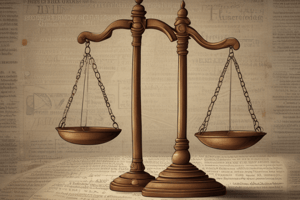Podcast
Questions and Answers
What is the main characteristic of primary rules according to Hart?
What is the main characteristic of primary rules according to Hart?
- They grant private citizens the right to vote.
- They impose duties upon citizens. (correct)
- They confer powers to individuals and institutions.
- They provide procedures to change or challenge primary rules.
What is an example of a primary rule?
What is an example of a primary rule?
- A procedure to make a legal will.
- A law that sets speed limits. (correct)
- A rule that determines the incidence of primary rules.
- A law that grants Congress the power to legislate.
According to Hart, what is the relationship between secondary rules and primary rules?
According to Hart, what is the relationship between secondary rules and primary rules?
- Secondary rules are a subset of primary rules.
- Secondary rules are parasitic upon primary rules. (correct)
- Secondary rules are in contrast to primary rules.
- Secondary rules are independent of primary rules.
What do secondary rules confer, according to Hart?
What do secondary rules confer, according to Hart?
What do primary rules impose, according to Hart?
What do primary rules impose, according to Hart?
What is the main function of secondary rules, according to Hart?
What is the main function of secondary rules, according to Hart?
What is the essence of a legal system, according to Hart?
What is the essence of a legal system, according to Hart?
What is an example of a secondary rule?
What is an example of a secondary rule?
According to Hart, what do primary rules tell citizens?
According to Hart, what do primary rules tell citizens?
What is the focus of secondary rules, according to Hart?
What is the focus of secondary rules, according to Hart?
Flashcards are hidden until you start studying
Study Notes
Primary Rules
- Imposing specific duties upon citizens to act in a certain manner
- Failure to comply may result in legal sanctions
- Examples: speed limits, laws prohibiting trespassing, laws prohibiting corporations from requiring employees to make political contributions
- Regulated by Hart's characterization as "basic" rules
- Define what citizens can and cannot do under the law
Secondary Rules
- Parasitic upon or secondary to primary rules
- Provide for the introduction, modification, or extinguishing of primary rules
- Confer powers, public or private, rather than imposing duties
- Examples: grant Congress the power to legislate, private citizens the right to vote, and procedures for making a legal will
- Regulated by Hart's characterization as power-conferring rules
- Determine the procedure for recognizing, changing, and adjudicating primary rules
Relationship between Primary and Secondary Rules
- Primary rules impose duties on citizens
- Secondary rules confer powers to introduce, modify, or extinguish primary rules
- Union of primary and secondary rules captures the essence of a legal system
- Secondary rules provide specific criteria to determine:
- What primary rules are in effect
- How primary rules can be changed
- Appropriate sanctions for violating primary rules
Studying That Suits You
Use AI to generate personalized quizzes and flashcards to suit your learning preferences.




